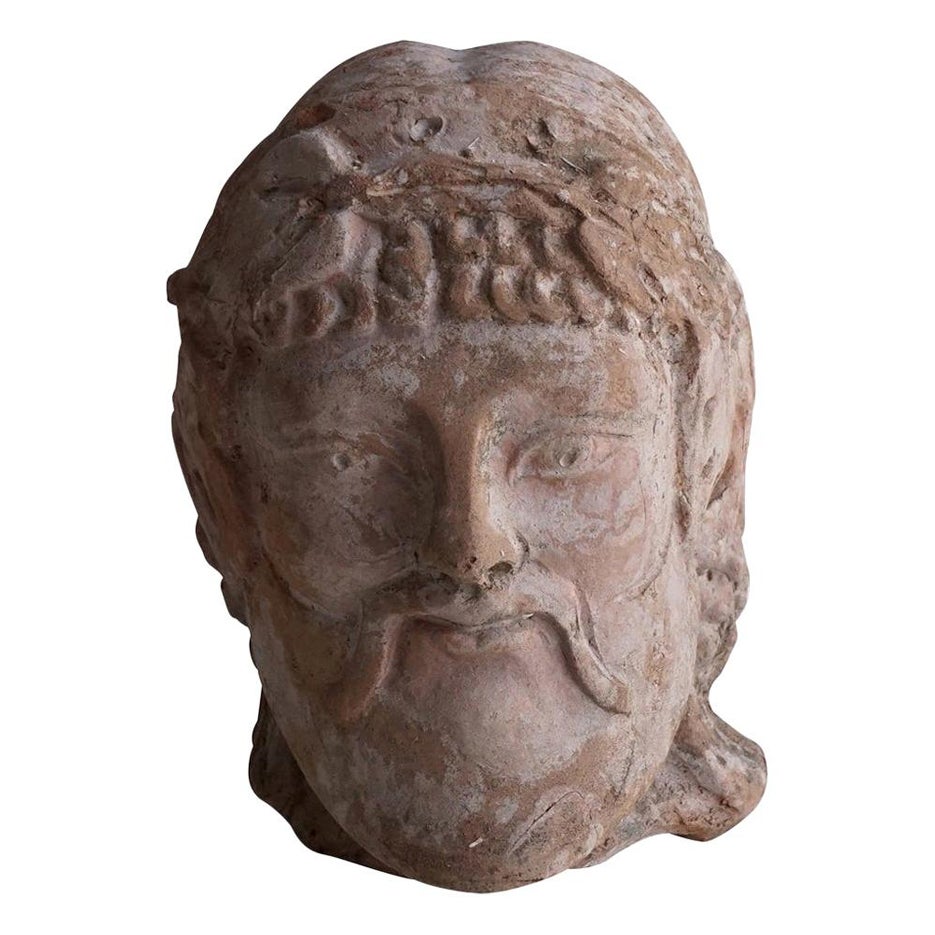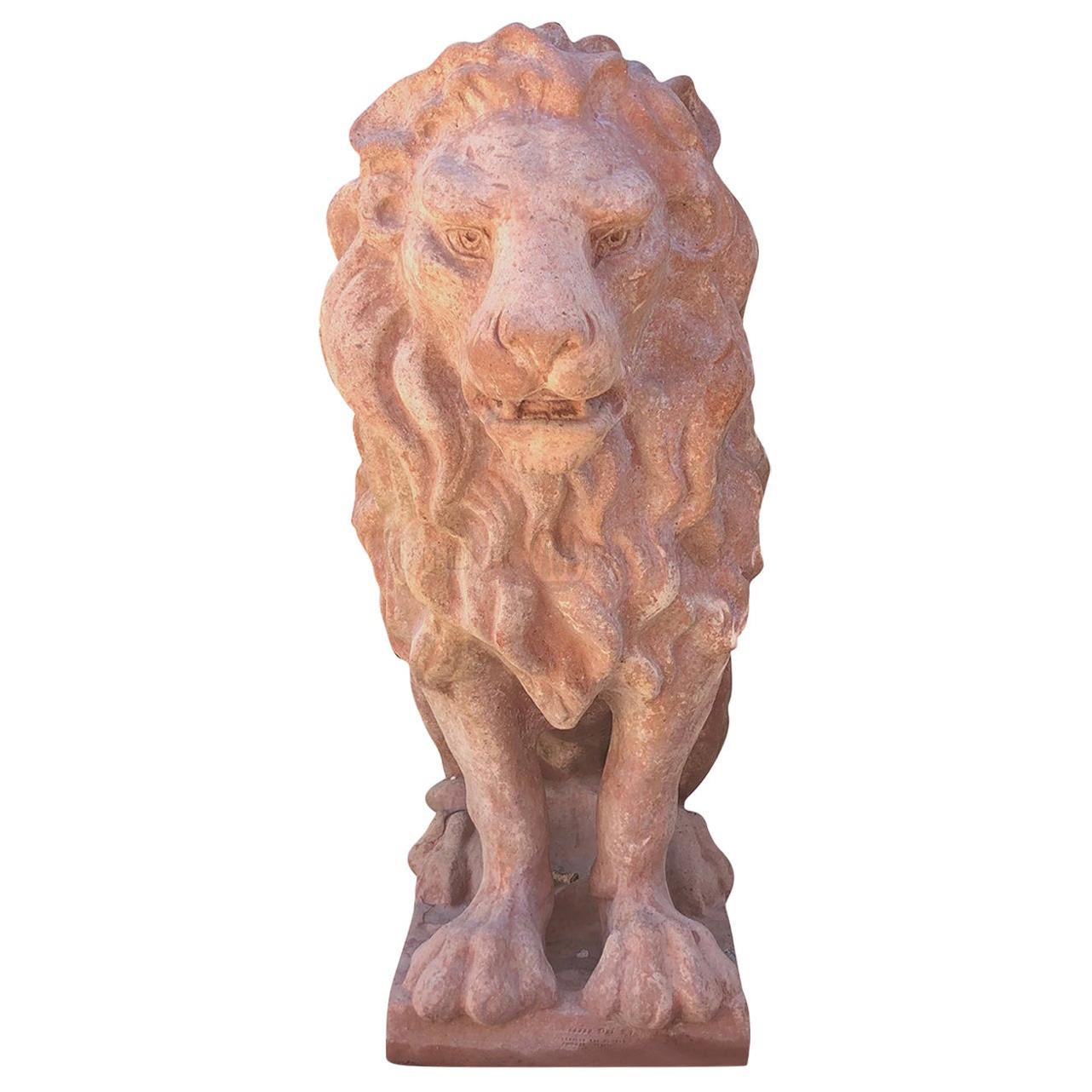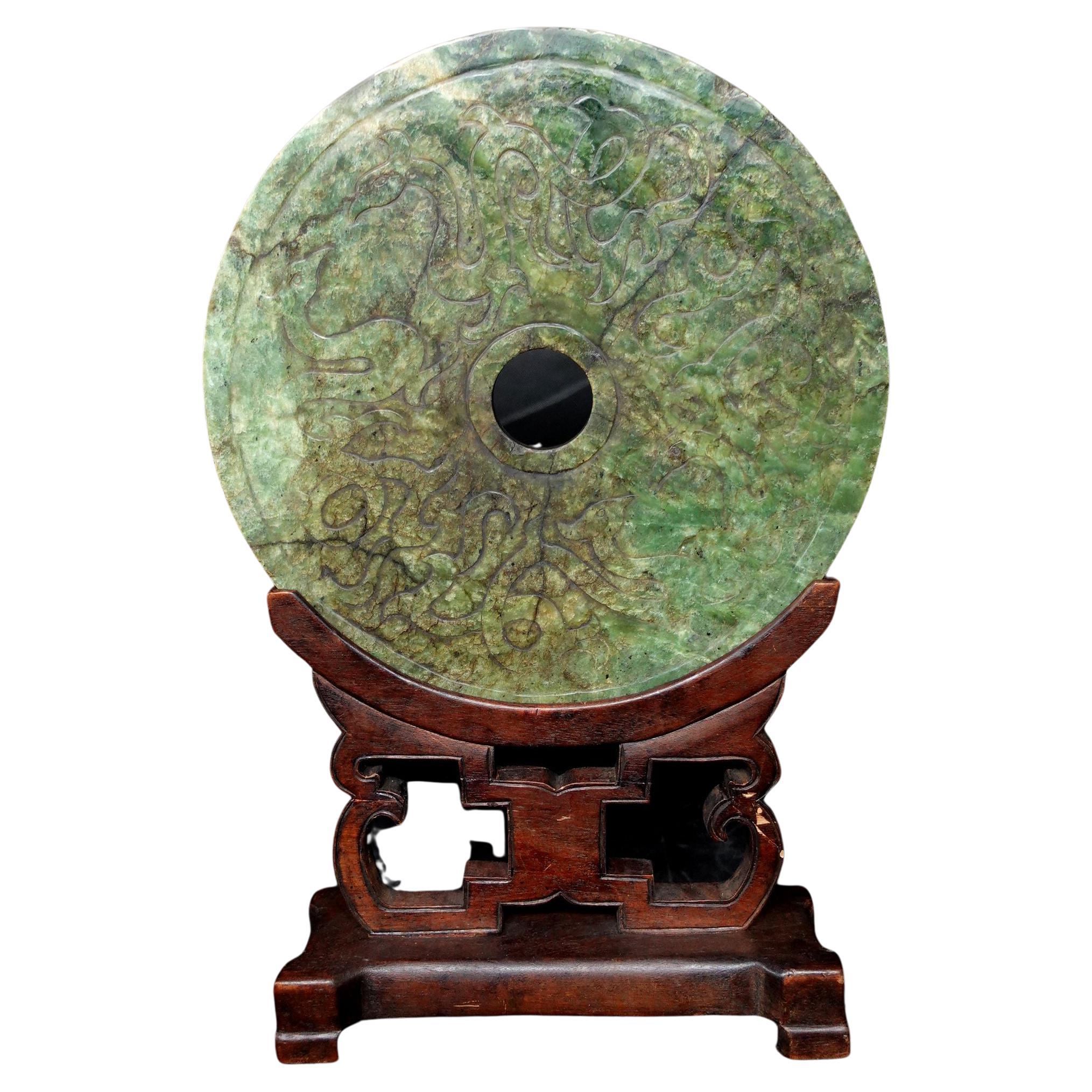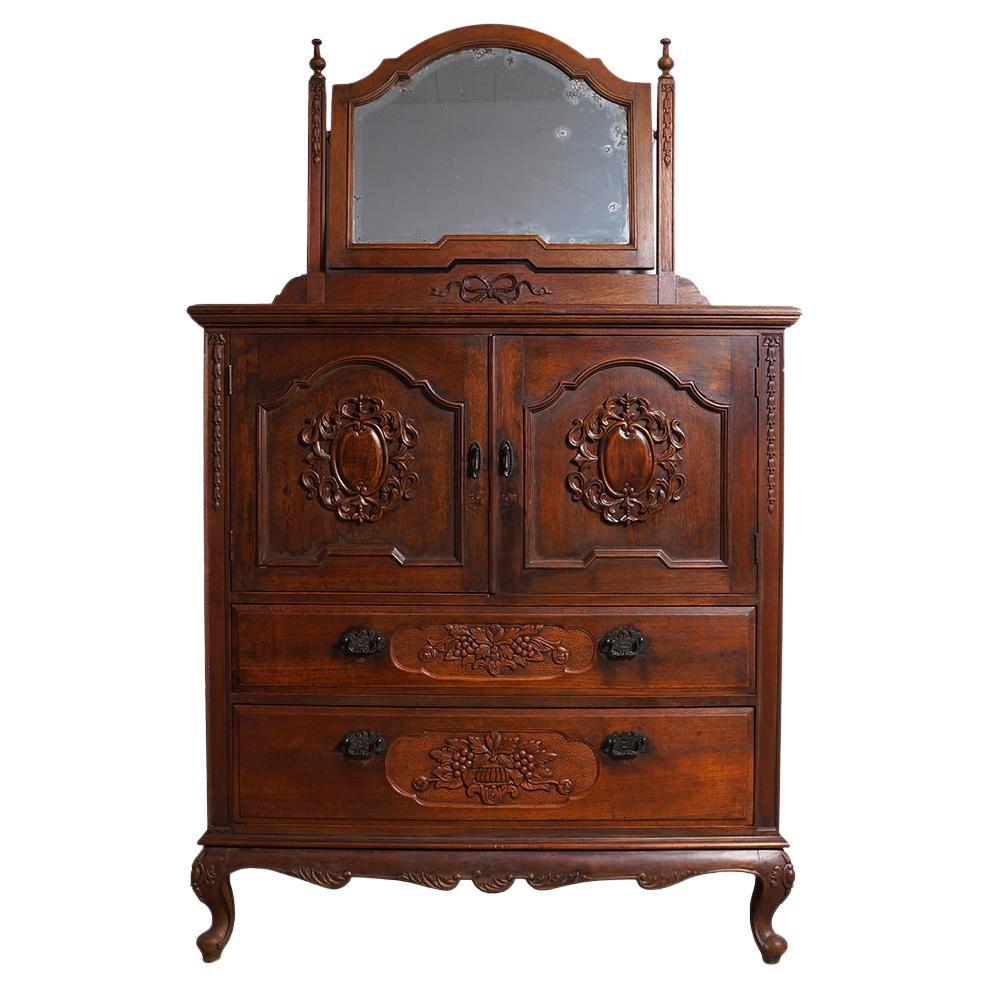Items Similar to Pair Antique Chinese Carved Celadon Jade Guardian Lions ROC Early 20th Century
Video Loading
Want more images or videos?
Request additional images or videos from the seller
1 of 13
Pair Antique Chinese Carved Celadon Jade Guardian Lions ROC Early 20th Century
About the Item
This exquisite pair of celadon jade guardian lions hails from the early Republic of China period, a testament to the era's craftsmanship. The lions are intricately carved from high-quality celadon jade, a material revered for its subtle, pale green hue and translucency. Each lion is depicted in a traditional pose, exuding both regality and ferocity, as if poised to protect the space they inhabit.
The masterful carving captures the intricate details of the lions' fur, facial features, and muscular form, lending a lifelike quality to these guardian figures. The jade itself is of superior quality, its natural luster further accentuated by the meticulous carving.
These guardian lions serve not only as stunning decorative pieces but also as symbols of power, strength, and prosperity. They would make a distinguished addition to any collection of fine Chinese art or serve as a focal point in a space designed to reflect cultural richness and artistic mastery.
circa 1910-1920, R.O.C period
- Dimensions:Height: 3.55 in (9 cm)Width: 1.97 in (5 cm)Depth: 2.76 in (7 cm)
- Sold As:Set of 2
- Style:Chinese Export (Of the Period)
- Materials and Techniques:
- Place of Origin:
- Period:
- Date of Manufacture:Circa 1910
- Condition:Wear consistent with age and use. Good antique condition, see detailed photos.
- Seller Location:Richmond, CA
- Reference Number:1stDibs: LU9161236790132
About the Seller
No Reviews Yet
Vetted Seller
These experienced sellers undergo a comprehensive evaluation by our team of in-house experts.
1stDibs seller since 2023
8 sales on 1stDibs
Typical response time: <1 hour
- ShippingRetrieving quote...Ships From: Richmond, Canada
- Return PolicyA return for this item may be initiated within 3 days of delivery.
Auctions on 1stDibs
Our timed auctions are an opportunity to bid on extraordinary design. We do not charge a Buyer's Premium and shipping is facilitated by 1stDibs and/or the seller. Plus, all auction purchases are covered by our comprehensive Buyer Protection. Learn More
More From This SellerView All
- Vintage Pair Chinese Pewter Guardian Foo Lions Hong Kong NG AN Signed Mid 20cLocated in Richmond, CAPair of vintage Chinese pewter guardian lions, in fierce sitting pose, with copper accents for sharp claws, and each topped with an adjustable height brass ball attached by a threade...Category
Mid-20th Century Chinese Chinese Export Sculptures and Carvings
MaterialsBrass, Pewter
- Antique Chinese Carved Celadon Jade Beauty Fairy Lady On Zitan Stand Qing 19cLocated in Richmond, CAThis masterfully carved celadon jade figure represents the epitome of Chinese artistry and craftsmanship. The sculpture features a beauty dressed in flowing traditional attire, capturing the essence of grace and elegance. She is depicted holding a plate that presents a branch bearing three peaches, a symbol of longevity and prosperity in Chinese culture. The jade used for this carving is of a refined celadon hue, adding a layer of sophistication and tranquility to the piece. The intricate detailing on the flowing dress and the lifelike representation of the peaches attest to the skill and precision involved in its creation. This celadon jade carving...Category
Antique Late 19th Century Chinese Qing Sculptures and Carvings
MaterialsJade
- Antique Chinese Serpentine Relief Carved Dragon Covered Vase ROC c.1920sLocated in Richmond, CAAntique Chinese ROC period early 20th Century hand carved serpentine stone covered bottle vase, finely plotted and carved with a high relief stylized dragon wrapped around the should...Category
Early 20th Century Chinese Qing Sculptures and Carvings
MaterialsSerpentine
- Monumental Chinese Spinach Jade Recumbent Tang Horse Rocky Variations 20th Cent.Located in Richmond, CAA monumental size (14kg) Chinese recumbent Tang Horse, circa mid to late 20th Century, possibly older. The sculpture is executed in Spinach Jade, a material highly prized for its dee...Category
20th Century Chinese Qing Sculptures and Carvings
MaterialsJade
- Large Antique Celadon Jade Ruyi Brush Wash Hand Carved Hydra Handles Qing 19cLocated in Richmond, CAA fine antique Chinese hand carved jade brush wash, in ruyi head form, sides flanked by 2 climbing hydras, and bottom carved with three raised circles fee...Category
Antique 19th Century Chinese Qing Sculptures and Carvings
MaterialsJade
- Antique Chinese Goldstone Carved Cranes Ibis Snuff Bottle Early 20c ROCLocated in Richmond, CADiscover this rare and exquisite shimmering goldstone snuff bottle from the Republic of China period (1910-1940), a representation of the era's refined craftsmanship. Made from the distinctive goldstone, the bottle captivates with its natural sparkle, resembling a night sky strewn with stars. Each side features a pair of gracefully carved cranes...Category
Early 20th Century Chinese Qing Scholar's Objects
MaterialsGlass
You May Also Like
- Large Early 20th Century Chinese Carved Jade VaseLocated in Austin, TXA large and impressive Chinese caved jade vase, Republic Period, circa 1930. Carved from one massive piece of jade. The vase carved with the He He Er Xian...Category
Early 20th Century Chinese Qing Sculptures and Carvings
MaterialsJade
- Early 20th Century Antique Chinese Wood Carved Buddha StatueLocated in Pomona, CAThis magnificent Chinese antique wood carved Happy Buddha statuary has very detailed hand carving works on it. It is all hand made and hand...Category
Early 20th Century Chinese Chinese Export Sculptures and Carvings
MaterialsBoxwood
- Early 20th Century Antique Chinese Bone Carved Elephant SculptureLocated in Pomona, CAThis magnificent antique Chinese bone carved elephant was 100% hand made and hand carved from OX bone. It has very detailed carving works on it. T...Category
Early 20th Century Chinese Chinese Export Sculptures and Carvings
MaterialsCopper
- Antique Chinese Carved Celadon Jade Buddha, 19th CLocated in Big Flats, NYAntique Chinese Carved Celadon Jade Buddha 19th C Measures- 3''H x 2''W x 1''DCategory
Antique 19th Century Asian Sculptures and Carvings
MaterialsJade
- Antique Chinese Carved Celadon Jade Buddha, 19th CLocated in Big Flats, NYAntique Chinese Carved Celadon Jade Buddha 19th C Measures- 3''H x 2''W x 1.5''DCategory
Antique 19th Century Asian Sculptures and Carvings
MaterialsJade
- A pair of 19th Century carved Foo temple dogs or Chinese guardian LionsLocated in London, GBChinese guardian lions, or imperial guardian lions, are a traditional Chinese architectural ornament. Typically made of stone, they are also known as stone lions or shishi (石獅; shíshī). They are known in colloquial English as lion dogs or foo dogs / fu dogs. The concept, which originated and became popular in Chinese Buddhism, features a pair of highly stylized lions—often one male with a ball and one female with a cub—which were thought to protect the building from harmful spiritual influences and harmful people that might be a threat. Used in imperial Chinese palaces and tombs, the lions subsequently spread to other parts of Asia including Japan (see komainu), Korea, Philippines, Tibet, Thailand, Myanmar, Vietnam, Sri Lanka, Nepal, Cambodia, Laos, and Malaysia. There has been extensive interaction between Chinese mythology and Confucianism, Taoism, and Buddhism. Elements of pre-Han dynasty mythology such as those in Classic of Mountains and Seas were adapted into these belief systems as they developed (in the case of Taoism), or were assimilated into Chinese culture (in the case of Buddhism). Elements from the teachings and beliefs of these systems became incorporated into Chinese mythology. For example, the Taoist belief of a spiritual Paradise became incorporated into mythology as the place where immortals and deities used to dwell. Sometimes mythological and religious ideas have become widespread across China's many regions and diverse ethnic societies. In other cases, beliefs are more limited to certain social groups, for example, the veneration of white stones by the Qiang. One mythological theme that has a long history and many variations involves a shamanic world view, for example in the cases of Mongolian shamanism among the Mongols, Hmong shamanism among the Miao people, and the shamanic beliefs of the Qing dynasty from 1643 to 1912, derived from the Manchus. Politically, mythology was often used to legitimize the dynasties of China, with the founding house of a dynasty claiming a divine descent. Mythology and philosophy. Further information: Chinese philosophy True mythology is distinguished from philosophical treatises and theories. Elaborations on the Wu Xing are not really part of mythology, although belief in five elements could appear. The Hundred Schools of Thought is a phrase suggesting the diversity of philosophical thought that developed during the Warring States of China. Then, and subsequently, philosophical movements had a complicated relationship with mythology. However, as far as they influence or are influenced by mythology, divides the philosophical camps into two rough halves, a Liberal group and a Conservative group. The liberal group being associated with the idea of individuality and change, for example as seen in the mythology of divination in China, such as the mythology of the dragon horse that delivered the eight bagua diagrams to Fu Xi, and methods of individual empowerment as seen in the Yi Jing (Book of Changes). The Liberal tendency is towards individual freedom, Daoism, and Nature. The relationship of the Conservative philosophies to mythology is seen in the legendary Nine Tripod Cauldrons, mythology about the emperors and central bureaucratic governance, Confucianism, written histories, ceremonial observances, subordination of the individual to the social groups of family and state, and a fixation on stability and enduring institutions. The distinction between the Liberal and Conservative is very general, but important in Chinese thought. Contradictions can be found in the details, however these are often traditional, such as the embrace by Confucius of the philosophical aspects of the Yi Jing, and the back-and-forth about the Mandate of Heaven wherein one dynasty ends and another begins based according to accounts (some of heavily mythological) where the Way of Heaven results in change, but then a new ethical stable dynasty becomes established. Examples of this include the stories of Yi Yin, Tang of Shang and Jie of Xia or the similar fantastic stories around Duke of Zhou and King Zhou of Shang. Mythology exists in relationship with other aspects of society and culture, such as ritual. Various rituals are explained by mythology. For example, the ritual burning of mortuary banknotes (Hell Money), lighting fireworks, and so on. A good example of the relationship of Chinese mythology and ritual is the Yubu, also known as the Steps or Paces of Yu. During the course of his activities in controlling the Great Flood, Yu was supposed to have so fatigued himself that he lost all the hair from his legs and developed a serious limp. Daoist practitioners sometimes incorporate a curiously choreographed pedal locomotion into various rituals. Mythology and practice, one explains the other: in these rituals, the sacred time of Yu merges with the sacral practice of the present. Various ideas about the nature of the earth, the universe, and their relationship to each other have historically existed as either a background or a focus of mythologies. One typical view is of a square earth separated from a round sky by sky pillars (mountains, trees, or undefined). Above the sky is the realm of Heaven, often viewed of as a vast area, with many inhabitants. Often the heavenly inhabitants are thought to be of an "as above so below" nature, their lives and social arrangements being parallel to those on earth, with a hierarchical government run by a supreme emperor, many palaces and lesser dwellings, a vast bureaucracy of many functions, clerks, guards, and servants. Below was a vast under ground land, also known as Diyu, Yellow Springs, Hell, and other terms. As time progressed, the idea of an underground land in which the souls of the departed were punished for their misdeeds during life became explicit, related to developments in Daoism and Buddhism. The underground world also came to be conceived of as inhabited by a vast bureaucracy, with kings, judges, torturers, conductors of souls, minor bureaucrats, recording secretaries, similar to the structure of society in the Middle Kingdom (earthly China). Chinese temple Dogs...Category
Antique 1860s Chinese Chinese Export Sculptures and Carvings
MaterialsHardwood
Recently Viewed
View AllMore Ways To Browse
Chinese Jade Lion
Chinese Art Jade
Antique Buddha Mandalay
Chinese Carved Quartz
Joyful European Antiques
Antique Balinese Carving
Turtle Dragon Sculpture
Burmese Kinnari Statue
All Birds Made From Stone
Metal Fire Place
Japanese Bamboo Lantern
Chinese Shadow Puppets
Chinese Temple Censer
Porcelain Figure Of Shouxing The God Of Longevity
Japanese Wooden Trunk
Japanese Carved Boxwood
Japanese Buddhist Temple Bell
Buddha Tara





